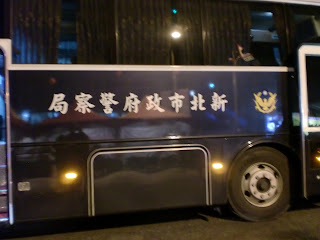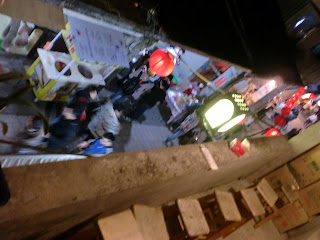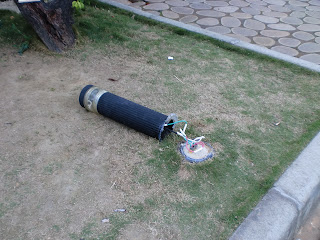週末は台北に行って来た!三日間しか無かったけど、時間を上手く使って結構回ったと思う。
一日目は北埔(ベープ)に行って来た。北埔は客家が沢山住み着いた地域で、現在も客家系の人が多い。昔ながらの客家系の煉瓦で出来ている建物も沢山有る。因みに、客家と言うのは、中国の一つの小民俗だ。漢人とされているけど、北京語じゃなくて、客家語を喋るし、独特な食べ物や建物など有るけん、小民俗と言っていいと思う。
I went to Taipei last weekend for a couple days. On the first day there, Friday, I went to Beipu, a town to the south of Taipei that is known for having a large number of old Hakka buildings. (For that matter, the town's population is supposedly still about 90% Hakka.) The Hakka are one group of Chinese people. They're usually counted as Han Chinese, not as one of China's separate ethnicities, but quite frankly I don't understand why. Their language is Hakka, not Mandarin, and while it is related to Mandarin, the two are mutually unintelligible. The Hakka people also have their own food and building style, etc, so I think it makes more sense to consider them a separate ethnicity, and I suspect that they are not considered one more for political reasons that anything else.
週末我去了臺北玩玩。只有三天,可是看到了很多地方。
第一天我去北埔。有很多客家的家,廟,等等。
バス降りたら、最初に寄って行った場所は廟だった。
The first place we visited was a small temple right near the bus stop. A guy we met on the bus told us a bunch of stuff about the temple. I, uh, kinda forget what he said though. Also, he was explaining history stuff to me in Chinese, so I only kind of got it to begin with.
昔は壊された皿を使ってこう言う立体物を作ったとバスで出会ったお兄さんから教えて貰った。(そのお兄さんは歴史に興味が有る人だから、色々な事を説明して呉れた。)
I do remember one thing he said, which was that they used to make the scales and stuff in the dragon statues above out of broken ceramic plates. Apparently they use something cheaper and less durable now.
我們在公車上跟一個台灣哥哥說話,他告訴我們以前台灣人用破了的盤子做這樣的東西。(差不多說那樣的。我一點聽不懂。)
I love the expressions and poses on animals in Chinese temple art.
中華式の廟の動物凄く気に入っている。表情とか、姿勢とか、全てが面白い。
我喜歡這些廟的動物。他們的臉奇奇怪怪地可愛。
太陽に「日」が書いているのもウケる。自分の美術力に自身無かった様だ。
我覺得這裡是道教的廟,可是也有佛教關係的畫。
This temple is, I'm pretty sure, a Daoist temple. However, there's still a scene featuring the Buddha here. Like Japan--where Shinto and Buddhism are often mixed together--it seems to be not uncommon in Taiwan for Daoism and Buddhism to be combined together.
町を歩き回ったら、だいたいこう言う感じだ。
對住在這裡的人來說,應該光客很麻煩。大家把舊的家的照片拍拍了。我也拍了一拍。對不起!
ここの家は民家で、実際に人が住んでいるのに、同時に町は観光地化されているので、毎日庭先に観光客が立って写真を撮っている。現地の人大変だろう。
These houses are very historic and make for nice photos, but people actually live in them, so I made sure to feel guilty and embarrassed while snapping photos of people's front yards.
「井戸じゃないから飲まないで下さい。」(アホ!飲むのか!?)
"This is not a well. Do not drink the water." They were nice enough to leave out the ", moron" at the end of the second sentence.
今年は巳(蛇)年だ!
It's the year of the Snake this year.
ここで一息してお茶を飲んだ。一息したと言っても、ここのおばさんの態度が凄くてあまりリラックス出来なかった。観光客が多いから、丁寧に人と接する必要無いだろう。入った時はすぐ「注文するのか?しないのか?」みたいな感じだった。又、お茶を飲んでいる途中、何も言わずに急に現れてポットを奪ってどこかに行ってしまった。後で新しいお湯を入れていると分かったけど、それ言って呉れなかったから、こっちは「ああ、飲むの遅かったから、終わっていないのに直されてしまった」と勘違いした。「早く飲んで出て行け」と言う印象がした。
We got tea in this very pretty shop. The waitresses were interesting too. They played good-cop, bad-cop with us. One of them was this middle-aged lady who seemed to be in a hurry to do everything and did not want to waste too much time on basic niceties, the other was this young woman who did everything very slowly and while speaking very kindly with us. With the two of them switching back and forth serving our table, it was a very disorienting tea experience.
あらあら、、、
怎麼了?為甚麼倒掉了?
客家のご先祖を記念する慰霊碑(?)みたいな物だ。
This building is a sort of memorial to the Hakka who originally settled this area and cleared the area for farming.
這是客家先祖的紀念碑。
新竹駅。日本時代に作られたこの駅はデザインが凄い。たしか国の指定文化財に成っていると聞いた事有る気がする。
After leaving Beipu we visited Hsinchu for a bit. This is the train station there. It was built during the Japanese colonial period.
我們出北埔去了以後,去新竹看看。新竹車站很棒!它應該是日本時代做的。
旧暦お正月関係で、こう言うやつが展示されていた。
They had a lot of lighted displays for the lunar new year.
この門を見たら、台南の
東大門を思い出す。
我看到這個門,我就想起來臺南的東大門。
This gate inside a traffic circle reminded me of
Big East Gate in Tainan, near Cheng Da's campus.


















































































